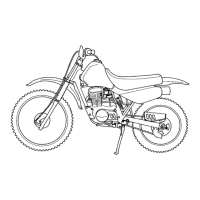
Do you have a question about the Honda XR100R 1996 and is the answer not in the manual?
| Bore x Stroke | 53.0mm x 45.0mm |
|---|---|
| Compression Ratio | 9.4:1 |
| Transmission | 5-speed |
| Front Brake | Drum |
| Rear Brake | Drum |
| Front Tire | 2.50-19 |
| Rear Tire | 3.00-16 |
| Ignition | CDI |
| Final Drive | Chain |
| Engine Type | air-cooled, four-stroke, single-cylinder |
| Front Suspension | Telescopic fork |
| Rear Suspension | Swingarm with single shock |
| Induction | 22mm carburetor |
Defines hazard symbols DANGER, WARNING, CAUTION and their meanings.
Explains NOTICE messages for preventing damage to motorcycle or property.
Congratulates the owner and introduces the manual's purpose and motorcycle features.
Emphasizes riding responsibly and protecting the environment.
Provides essential safety advice for operating the motorcycle.
Offers guidance for parents regarding young riders and safety.
Discusses safe loading, accessories, and modifications.
Locates and explains the importance of safety labels on the motorcycle.
Details the function of handlebar controls like throttle and levers.
Explains controls located on the engine and chassis, such as fuel valve and side stand.
Identifies foot-operated controls like the kickstarter and rear brake pedal.
Assesses the rider's physical and mental readiness for riding.
Recommends essential protective gear for safe riding.
Outlines crucial checks before operating the motorcycle.
Covers initial riding precautions and engine break-in guidelines.
Details procedures for starting the engine, shifting gears, and braking.
Explains how to stop, park the motorcycle, and perform post-ride checks.
Highlights the significance of maintenance and associated safety precautions.
Outlines the recommended maintenance schedule and a record-keeping system.
Covers component locations, tools, and general procedures for critical systems.
Provides tips for preparing for a ride, including safety and planning.
Offers guidance on transporting and storing the Honda motorcycle.
Advises on responsible riding and environmental protection.
Offers general guidelines for troubleshooting and handling issues.
Addresses problems like a non-starting engine or flat tires.
Provides advice for post-crash checks and component failures.
Details vehicle identification numbers and technical specifications.
Information regarding noise emission standards and regulations.
Information on service manuals, warranty coverage, and dealer contact.
Tips on how to prevent costly repairs by proper maintenance.
A table summarizing essential maintenance intervals, capacities, and specifications.